#from hridayam
Explore tagged Tumblr posts
Text

Just an image I made for bluespandas' fic "Anuragam nenjin ullil kotta paniyum" based on the Malayalam movie Minnal Murali. Just for fun!
#minnal murali#Jaison#benny#oc#original male character#bisexual Jaison#photographer benny#who for some reason looks like#pranav mohanlal#from hridayam#malayalam cinema#queer#queering Malayalam cinema#based on fanfiction
2 notes
·
View notes
Text

Pha Yant: of lord surya (the sun) “a ruby flashing in the sky” Credit: JintheNinja (金齊天大聖)
Surya Mantra
÷÷÷÷÷÷÷÷÷÷÷÷÷
"Japakusumsankasham Kashypeyam Mahadhyutim
Tamorim Sarvapaapagnam Prantosmi Divakaram"
Meaning : I bow down to the Sun God who is the cause of the day break, who dispels all darkness, who destroys all sins , who is matchless in brilliance, who is the son of Kashyapa and who is as red as a Japa Kusuma flower.
Surya Gayatri Mantra OM Bhaskaraya Vidmahe Mahadyutikaraya Dhimahi Tanno Adityah Pracodayat'
According to Hindu Mythology, Sun is a Kshatriya and born to Sage Kashyap and Aditi who is the mother of Gods. Her sons were defeated by the demons. Aditi prayed to the sun to be born as her son to fight and defeat the demons so that the Gods could get back their due. Sun agreed to it and was born as Aditya. Hindus believe that Sun is ever moving in a chariot drawn by seven horses. Surya, the Sun, is short in stature and has a prominent, shining appearance, with two arms, a curly mane of hair and shining, golden-brown eyes that are the exact color of honey. His mind is incisive and His complexion coppery or golden and He wears clothes of dark saffron. In both His hands, Surya has two red lotuses. The wheel of Surya's chariot represents the year and its twelve spokes are the twelve months.
God Surya (सूर्य) can be called the only god in Hindu religion who can be seen and prayed to in daily life. The Surya is depicted as having a body as shiny and radiant as pure gold. He is believed to be a golden red man with three eyes and four arms, riding a chariot driven by seven white horses. The Chariot harnessed by seven horses represent the seven colours of the rainbow or the seven chakras.
Surya is the life giver, sustaining all life on earth by providing all radiance and energy. He by mounting the wheel of time is also the one who is responsible for the beautiful seasons and causing the cycle of day and night.
The Surya is referred to in Sanskrit as "Mitra" or "Friend" down to the invariable warmth. Surya is depicted with two hands holding a lotus in both; sometimes he has four hands holding a lotus, chakra, a conch and a mace.
Surya in ancient literature
In Vedas, numerous hymns are dedicated to Surya, the Sun personified, and Savitr, "the impeller", a solar deity either identified with or associated with Surya. Even the Gayatri mantra, which is regarded as one of the most sacred of the Hindu hymns is dedicated to the Sun. The Adityas are a group of solar deities, from the Brahmana period numbering twelve. The ritual of sandhyavandanam, performed by some Hindus, is an elaborate set of hand gestures and body movements, designed to greet and revere the Sun.
The mantra in Rig Veda praise to the Surya as :
आ कृष्णेन् रजसा वर्तमानो निवेशयन्न अमृतं मर्त्यं च । हिरण्ययेन सविता रथेना देवो याति भुवनानि पश्यन ॥ (1/35)
(Throughout the dusky firmament advancing, laying to rest the immortal and the mortal, Borne in his golden chariot he cometh, Savitar, God who looks on every creature]
Gaytri Mantra in Vedas for Lord Surya
ॐ भूर्भुवः॒ स्वः॒ तत्स॑वितुर्वरे॑ण्यम् भ॒र्गो॑ दे॒वस्य॑ धीमहि। धियो॒ यो नः॑ प्रचो॒दया॑त्॥
(Om bhoor-bhuvaH svaH, tat-savitur-vareNNyam, bhargo devasya dheemahi, dhiyo yo naH prachodayaat.)
In the Vedas Surya Dev is referred to as the god of light who is responsible for all life on earth.
The Children of lord Surya are : Shani Deva (शनि), Yama, Yamuna, Tapti
Names of Surya
Ravi, Suraj, Aditya, Adit, Bhaskar, Pusha, Divakar, Bhanu
Vedic Mythology with stories
The Mahabharata describes one of its warrior heroes Karna as being the son of the righteous queen Kunti and the Sun. The Ramayana describes Lord Ram (श्री राम) as being descended from the Surya Vansh or the clan of kings as bright as the Sun. The Sun God is said to married to the beautiful goddess Ranaadeh, also known as Sanjnya. She is depicted in dual form, being both sunlight and shadow, personified. The charioteer of Surya is Arun, who is also personified as the redness that accompanies the sunlight in dawn and dusk.
Sun God in different cultures
The Solar deities associated with different aspects of the cultural universe of the society, but for the most part its raw image remains identical. In the 3rd millennium BC, the winged sun was an ancient symbol of Horus. The Neolithic concept of a solar barge, the sun as traversing the sky in a boat, is found in the later myths of ancient Egypt, with Ra and Horus. Egyptian myths imply that the sun is within the lioness,
Proto-Indo-European religion has a solar chariot, the sun as traversing the sky in a chariot. During the Roman Empire, a festival of the birth of the Unconquered Sun was celebrated when the duration of daylight first begins to increase after the winter solstice, — the "rebirth" of the sun.
In Germanic mythology this is Sol, in Vedic Surya, and in Greek Helios (occasionally referred to as Titan) or Apollo. Mesopotamian Shamash plays an important role during the Bronze Age, and "my Sun" is eventually used as an address to royalty. South American cultures have emphatic Sun worship. Svarog is the Slavic god sun and spirit of fire. In Aztec mythology, Tonatiuh was the sun god. The Aztec people considered him the leader of Tollan, heaven.
Surya in vedic Astrology
God Surya is the King of all the planets and is responsible for controlling all their movements. The Sun in Vedic astrology is called RAVI, or SURYA. In western tropical astrology, the Sun rules the Sign of Leo. He is exalted in the sign of Aries, and he is in his fall in the sign of Libra. In vedic astrology the Sun is known as the ATMAKARAKA, means .an "indicator of the soul." The Sun is the indicator of the father, our ego, honors, status, fame, the heart, the eyes, general vitality, respect and power.
He is particularly beneficial for the fire sign Ascendants of Aries, Leo, and Sagittarius. His nature, or temperament is PITTA, or fiery, and the gemstone associated with the Sun is the red ruby. The Sun's metal is Gold and his direction is east. His day is Sunday, and he comes into full maturity and brilliance at age 22.
The Vedas adore him as a witness (Sakshi) of all actions. He is the lord of Leo in the Zodiac. He stays one month in each Rasi and takes 365 days or 12 months to complete a round of 12 Rasis. Worship of Surya on Sunday is supposed to bring in manifold benefits to the worshippers. .
Surya and modern Astronomy
Our solar system consists of an average star we call the Sun, the planets Mercury, Venus, Earth, Mars, Jupiter, Saturn, Uranus, Neptune, and Pluto. It includes: the satellites of the planets; numerous comets, asteroids, and meteoroids; and the interplanetary medium. The planets, most of the satellites of the planets and the asteroids revolve around the Sun in the same direction, in nearly circular orbits.
Our solar system the part of whole solar system, together with the local stars visible on a clear night, orbits the center of our home galaxy, a spiral disk of 200 billion stars we call the Milky Way. Again Our galaxy, one of billions of galaxies known, is traveling through intergalactic space. The order of planets revolving around the Sun are: Mercury, Venus, Earth, Mars, Jupiter, Saturn, Uranus, Neptune, and Pluto.
On February 14, 1990, the cameras of Voyager 1 pointed back toward the Sun and took a series of pictures of the Sun and the planets, making the first ever "portrait" of our solar system as seen from the outside.
Prayers to please Lord Surya
Surya namaskāra
Lord Surya helps one gain his eyesight and SURYA NAMASKAR will strengthen one's bones, cure illness, however severe it may be, cleanses the devotee from his sins and bestows on him progeny, wealth, good-health and long life. He is the cause for rainfall benefiting the world.
The lord Surya is prayed in the simplest way by folding one's hands in a namaskar at the time of sunrise. A simple chant of Om Suryaye Namah pleases the lord Surya. A Hindu worship Lord Surya at the rising of the Sun, known as Surya namaskāra There are twelve physical postures (asanas), which correspond to the twelve signs of the zodiac. During the sun's apparent journey through the heavens it passes through each of zodiac, and is said to triumph over each sign as it enters its domain. Associated with each other of the twelve positions of Surya Namaskar is a specific mantra. The 12 mantras for surya namaskara:
ॐ मित्राय नमः (aum mitrāya namah) ॐ रवये नमः (aum ravayé namah ) ॐ सूर्याय नमः (aum sūryāya namah ) ॐ भानवे नमः (aum bhānavé namah ) ॐ खगय नमः (aum khagāya namah ) ॐ पुष्णे नमः (aum pushné namah) ॐ हिरण्यगर्भाय नमः (aum hiranyagarbhāya namah) ॐ मारिचाये नमः (aum mārichāyé namah) ॐ आदित्याय नमः (aum ādityāya namah) ॐ सावित्रे नमः (aum sāvitré namah) ॐ आर्काय नमः (aum ārkāya namah) ॐ भास्कराय नमः (aum bhāskarāya namah)
The Gayatri Mantra is also associated with Surya.
Another hymn associated with Surya is the Aditya Hridayam, recited by the great sage Agastya to Lord Ram (श्री राम) on the warfield before the fight with Ravana in Lanka. .
42 notes
·
View notes
Text
THE SECRET LOCUS OF THE SELF
D. Then whom do you address when you say ‘ know thyself ‘?
M. To whatever you are; to you is given the suggestion 'know thyself'. The ego-self when it feels the necessity to know its own origin or feels impelled to rise above itself, takes the suggestion and goes deeper, and there discovers the true source and reality of itself. So the ego-self beginning to know itself ends in perceiving its Self.
D. Now, you were telling me that the Heart is the center of the Self …
M. Yes, it is the one supreme center of the Self. You need to have no doubt about it. The Real Self is there in the Heart behind the jiva or ego-self.
D. Now be pleased to tell me where it is in the body.
M. You cannot know it with your mind. You cannot realize it by imagination, when I tell you here is the center (pointing to the right side of the chest).
The only direct way to realize it is to cease to fancy and try to be yourself. Then you realize, automatically feel, that the center is there.
This is the center, the Heart, spoken of in the scriptures as hrith-guha, cavity of the Heart, arul ullam.
D. In no book have I found it stated that it is there.
M. Long after I came here I chanced upon a verse in the Malayalam version of Ashtanga hridayam, the standard work on Ayurveda, wherein the ojas sthana is mentioned as located in the right side of the chest, called the seat of consciousness, samvit. But I know of no- other work, which refers to it as being located there.
D. Can I be sure that the ancients meant this center by the term ‘Heart’?
M. Yes, that is so. But you should try to have rather than to locate, the experience. A man need not go to find out where his eyes are situated when he to see.
The Heart is there ever open to you if you care to enter it, ever supporting all your movements, even when you are unaware. It is perhaps more proper to say that the Self is the Heart itself than to say it is in the Heart. Really, the Self is the Center itself. It is everywhere aware of itself as ‘Heart’, the Self-awareness. Hence I said, " Heart is Thy name."
D. Has anyone else addressed the Lord thus, naming him the Heart?
M. Long after I said this, one day I came a hymn in St. Appar's Thevaram, where he mentions the Lord by the name ullam, which is the same as the Heart.
D. When you say that the Heart is the supreme center of the Purusha, the Atman, you imply that it is not one of the six yogic centers.
M. The yogic chakras counting from the bottom to the top are various centers in the nervous system represent various steps manifesting different kinds of power or knowledge leading to the Sahasrara, the thousand-petalled lotus where is seated the supreme Shakti.
But the Self that supports the whole movement of Shakti is not placed there but supports it from Heart center.
D. Then it is different from the Shakti manifestation?
M. Really there is no Shakti manifestation apart from the Self. The Self has become all this Shakti.
When the yogi rises to the highest center of trance, Samadhi, it is the Self in the Heart that supports him in that state, whether he is aware of it or not. But if he is aware in the Heart, he knows that whatever states or whatever centers he is in, it is always the same truth, the same Heart, the one Self, the Spirit that is present throughout, eternal and immutable.
The Tantra Shastra calls the Heart Suryamandala or solar orb, and the Sahasrara, Chandramandala or lunar orb. These symbols present the relative importance of the two, the atma-sthana and the shakthi sthana.
- Sat Darshana Bhashya and Talks with Sri Ramana Maharshi

2 notes
·
View notes
Note
😒 + 🎶
thank you 🌺
😒 - Biggest pet peeve
I sometimes get easily stressed out and tend to push too much of these issues onto my peers, which tends to be annoying at times. But I have learned to control my stress and take one thing at a time, instead of being overwhelmed.
🎶 - Top 5 favourite songs.
There are too many songs which I like cause they are varied across languages, so I'm sorting them according to language. The ones in brackets are from the respective movies:
English:
1. Perfect - Ed Sheeran
2. Lover - Taylor Swift
3. What Makes You Beautiful - One Direction
4. A Thousand Years - Christina Perri
5. Until I found you - Stephen Sanchez
Telugu:
1. The entire Hi Nanna movie Album (Hesham Abdul Wahab)
2. The entire Sita Ramam Album (Vishal Chandrashekar)
3. O Rendu Prema Meghalila (Baby)
4. Sirivennela (Shyam Singha Roy)
5. Kammani (Yeto Vellipoyindi Manasu)
Hindi:
1. Sun Saathiya (ABCD 2)
2. Kaala Chashma (Bar Bar Dekho)
3. Sona Kithna Sona (Crew)
4. Masth Magan (2 states)
5. Balam Pichkari (Ye Jawani Hai Diwani)
Honorable Mentions (Malayali Songs):
Darshana and Onakka Munthiri (Hridayam)
They are all a mix of melodious and fast beat songs cause I like to listen to them all according to my mood.
2 notes
·
View notes
Note
ask game so we can tag phan!! shuffle your favorite playlist and post the first five songs that come up + if you think they can be related to DnP or not. Copy/paste this ask to your favorite mutuals!!
yesss!! ok i know everyone's giving like english songs and thats understandable, but like,,
there's so many telugu ones that i think would suit them!! so ill do an non telugu one and a telugu one :
telugu:
1. Pachchadanamey from Sakhi (dnp)
2. Sada Nannu from Mahanati (dan)
3. Ee Hridayam from Ye Maaya Chesave (dnp)
4. Yeto Vellipoyyindi Manasu from Ninne Pelladutha (dnp)
5. Ammadi fro Hi Nanna (phil)
ok now non telugu:
1. Mast Magan from 2 States (dan)
2. Temptation by Raveena (idk man just vibes)
3. i read a fic called "stardust trailing back to you" and the author made a playlist for it so ever since then i associate Aliens Exist by blink-182 with them (purely vibes)
4. Sweet Love by Junko Ohashi (dnp)
5. Mohabbat by Arooj Aftab (go listen to this pleeeeaseee) (dan)
#phan#ask#anon#shoutout to stbty that was one gold fic#i loved it so much#anyways#note to anyone who finds this: listen to those songs theyre good!!
2 notes
·
View notes
Text
Pranav Mohanlal's Hridayam Re-Releases In Theatres On The Occasion Of Valentine's Day
Malayalam Movie ‘Hridayam’ Re-Releases ( Photo Credit – Hridayam Poster ) Pranav Mohanlal’s Malayalam hit movie “Hridayam”, which has collected Rs 50 crore from theatres, has re-released. According to the movie’s producer, Vyshakh Subramaniam, it is screening at select theatres on Valentine’s Day. The movie was theatrically released on January 21 last year, and was one of the highest-grossing…

View On WordPress
4 notes
·
View notes
Text
VERY GOOD MORNING TO ALL
ADITYA HRIDAYAM (STOTRA FOR OBTAINING BLESSINGS OF SURYA DEVTA) 🍀🍒
The Aditya Hridayam, is a hymn in glorification of the Sun or Surya and was recited by the great sage Agastya to Lord Rama on the battlefield before fighting with Ravana.
This historic hymn starts at the beginning of the Battle with Ravana, when Lord Rama is fatigued and getting ready to fight. The mystical hymn is dircted to the Sun God, the illustrious lord of all victories.
The Aditya-Hridyam Hymn is part of the Yuddha Kanda of Valmiki Ramayana (the chapter of war) and contains 31 slokas.
Nama Suryaya Santaya Sarvaroga Nivarine |
Ayu rarogya maisvairyam dehi devah jagatpate ||
Oh Lord Surya, ruler of the universe, you are the remover of all diseases, the repository of peace
I bow to you. May you bless your devotees with longevity, health and wealth
BENIFITS OF RECITING ADITYA HRIDAYAM 🍀
1. By reciting Aditya Hridaya Stotra Sri Rama killed Ravana and achieved Victory.
2. "Tejaskamo Vibhavasum" people desirous of Tejas-Aura around them, have to recite Aditya Hridaya Stotra. This is stated in Bhagavata.
3. By the grace of Surya Kunti Devi was blessed with Karna . Monkey Rurajasa with Sugreeva as his son
4. Satrajit obtained Syamantaka-mani by worshipping Surya.
5. Dharma Raja obtained Akshaya patra by worshipping Lord Surya and he used to entertain his guests with this wish yielding bowl.
6. "Dinesam Sukhardham" It is stated in Skanda purana that one has to pray to Surya Bhagavan for happiness and welfare.
7. The Samba purana declared that Samba the son of Jambavati could get himself cured of his leprosy by worshipping Lord Surya.
8. Mayurabhatta could make his body akin to a Diamond and became free from disease.
Sunday is the day of Surya.
One must avoid Liquor and Meat on Sundays.
Veda has stated that it is essential to get up early before sun rise.
One must get up in the early morning and offer oblations to Sun God. It is desirable to take bath in any lake or pond or river.
Stand opposite to Sun God and offer the Arghya.
Then the Cosmic rays covering the flowing water in Arghya pradana will emanate the power received from the rays of Sun and they project on our body.
SAPTA SAPTIH – SURYA BHAGVAN
1. He possesses Seven horses (Seven rays)
They are Jaya, Ajaya, Vijaya, Jitaprana, Jitakrama, Mano Japa, Jita Krodha (Bhavisya purana)
Jaya : The first ray bestows firm conviction, mental and physical strength generosity domination of others and benevolence.
Ajaya : gives Compassion, tranquility and intelligence, inward understanding.
Vijaya : Voracious reading, high thinking and spiritual base.
Jita prana : Deep thinking, extremely kind, merciful.
Jita krama : grants high quality discipline, very knowledgeble & scientific evaluators.
Manojapa :
Dedication & devotion, sincere and pursues the path of truth.
Jita krodha : In depth evaluation, artistic taste in fine arts and adoration of beauty, love for display.
2. The Seven Chandas : (poetic metres)
1. The Gayatri
2. Jagati
3. Usnik
4. Tristupp
5. Anustupp
6. Pankti became the six horses.
7. the Bhruhati chanda has became seat in middle of the Chariot.
Surya Bhagavan sits on this Chariot of Chandas & travel on the space.
3. Lord Surya has Seven rays :
These are
1. Susumna
2. Suradana
3. Udanvasu
4. Visvakarma
5. Udavasu
6. Visvavyaca
7. Harikesa
“Susumna”: This is equivalent to the brightness of thousand rays.
This ray with this name make Chandra (Moon) most beautiful one.
The Nectar given
by fullmoon to all bestows on them happiness and pleasure.
“Surandana” : The moon has originated from this ray.
Even the rays of are only rays of Surya (Sun) alone.
“Udannvasu” : From this the Kuja graha (planet) is originated.
This ray of Surya will protect living being from defects of blood & gives them health, brilliance & wealth.
“Visva karma” : This constructs the Budhagraha (planet).
This ray will remove mental agitations of people & grants all auspiciousness and peace.
“Udavasu” : This ray constructs Brihaspati planet.
This planet grants pleasures & liberation to all living beings.
By worshipping this planet all hurdles, obstructions, opposition will be removed & success is achieved.
“Visva vyaca” : From this ray Sukra & Sani have originated.
Among them Sukra is responsible for Virya (sperm) Sukra is incharge of humans procreation & also his ray brings death.
Hence by worshipping this
ray one will get complete longevity.
“Harikesa” : Due to this ray, all Stars (Nakshatras) are born.
These come to be known as Nakshatra because they are protecting human bodies from loss of strength, Virya & Teja.
Surya has seven service personnel
They are
1. Nakshatras
2. Months
3. Fortnights
4. Seasons
5. Years
6. Days
7. Nights.
He has Seven Indriyas (organs) they are
1. Two eyes 2. Two Nostrils 3. Two ears 4. One face.
Surya Bhagavan is the person that activates the functions of these organs.
6. He has a Horse by name Sapta.
Having a Chariot with this name he
is called as Sapta Sapti.
This name is denoted at end of Kalki Avatara riding this horse.
The seven colours of Suryadeva : 1. Red 2. Orange 3. Yellow 4. Green 5. Blue 6. Indigo 7. Violet, are the seven horses of Surya 🍀🍒
Full Credits : Aavesh Tapde ji
Stay safe stay better
3 notes
·
View notes
Note
🎶✨when u get this u have to put 5 songs u actually listen to, publish. then, send this ask to 10 of your favorite followers and friends (no pressure it’s just for fun if you feel like it)
Aight
Count me Out by Kendrick Lamar
Rush by Raveena
Cherry by Rina Sawayama
Darshana by Darshana Rajendran (from Hridayam)
Chaudhary by Mame Khan
2 notes
·
View notes
Text

Consult the expert back pain doctor Noida at Ayur Hridayam for holistic treatments that alleviate pain using the best of Ayurveda and natural therapies. Their treatments are tailored to restore balance and improve your quality of life. If you are suffering from back pain book your appointment now.
0 notes
Text
Exploring Shastric Medicines: Ancient Wisdom, Modern Wellness
Ayurveda, the ancient Indian system of medicine, has long been revered for its holistic approach to health and wellness. At the heart of Ayurveda lies the concept of Shastric medicines, formulations deeply rooted in classical Ayurvedic texts, meticulously crafted over centuries. These formulations are known for their precise combination of herbs, minerals, and natural ingredients that address a wide array of physical and mental conditions. One trusted source of these traditional medicines is Sahasrayogam, which offers a vast collection of Shastric medicines known for their authenticity and efficacy.
What are Shastric Medicines?
Shastric medicines are Ayurvedic formulations derived from ancient scriptures (Shastras) that provide detailed descriptions of herbal combinations and their therapeutic effects. These medicines are prepared following traditional methods as outlined in ancient texts like Sahasrayogam, Ashtanga Hridayam, Charaka Samhita, and Susruta Samhita. They are categorized based on specific health concerns, such as digestive issues, respiratory conditions, neurological health, and more.
The Manufacturing Process
Manufacturing Shastric medicines is an intricate process that requires precision, skill, and a deep understanding of Ayurvedic principles. At Sahasrayogam, every product undergoes a step-by-step procedure to ensure purity and potency:
Raw Material Selection: Only the finest quality herbs, minerals, and ingredients are selected, ensuring they meet Ayurvedic standards for medicinal use.
Purification (Shodhana): The raw materials are purified through specific processes to eliminate impurities and enhance their therapeutic properties.
Formulation Preparation: According to the exact ratios and procedures described in Ayurvedic texts, ingredients are mixed, boiled, fermented, or processed in ways that activate their medicinal benefits.
Quality Control: Before reaching the market, these medicines undergo rigorous testing to meet modern safety and quality standards while maintaining their traditional essence.
Popular Shastric Medicines at Sahasrayogam
At Sahasrayogam, a wide range of Shastric medicines are available to treat various health issues. Some of the notable categories include:
Arishtas and Asavas: Herbal fermented liquid medicines used to treat digestive disorders, respiratory issues, and general weakness. Their fermentation process enhances bioavailability, making them effective in restoring health.
Kashayams: These herbal decoctions are known for their quick absorption and are often used in treating fever, infections, and inflammatory conditions.
Lehyams: Herbal jams and pastes made with a combination of herbs and natural sweeteners. Lehyams are highly nutritive and are used for rejuvenation, boosting immunity, and improving vitality.
Vatis (Tablets): Compressed herbal formulations that are easy to consume and used to treat a wide range of conditions, from digestion issues to mental health concerns.
Why Choose Sahasrayogam for Shastric Medicines?
Sahasrayogam ensures that every product stays true to the original Ayurvedic texts. By combining the best of ancient Ayurvedic wisdom with modern manufacturing practices, Sahasrayogam offers premium-quality Shastric medicines. The benefits of choosing these authentic formulations include:
Purity and Efficacy: Each product is made from the highest quality ingredients, ensuring maximum therapeutic benefits.
Traditional Formulations: All products strictly adhere to the classical methods outlined in the ancient Ayurvedic texts.
Quality Assurance: Advanced technology ensures that the medicines meet stringent safety standards, without compromising their traditional values.
Conclusion
For those seeking natural, time-tested solutions for health and wellness, Shastric medicines from Sahasrayogam are an excellent choice. Whether you are looking for herbal tonics to boost your vitality or remedies for specific health conditions, Sahasrayogam’s range of products offers the best of Ayurveda. With a foundation in ancient texts and a commitment to modern quality, these formulations provide holistic healing for mind, body, and spirit.
0 notes
Text
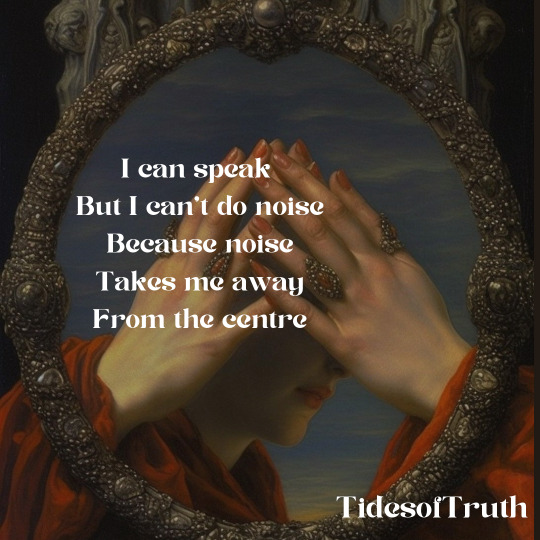

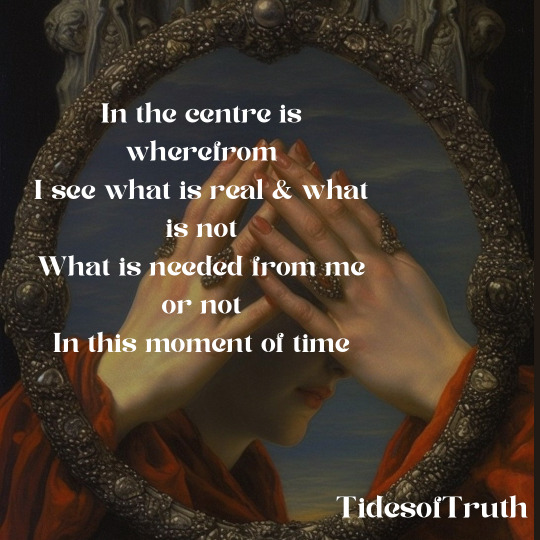
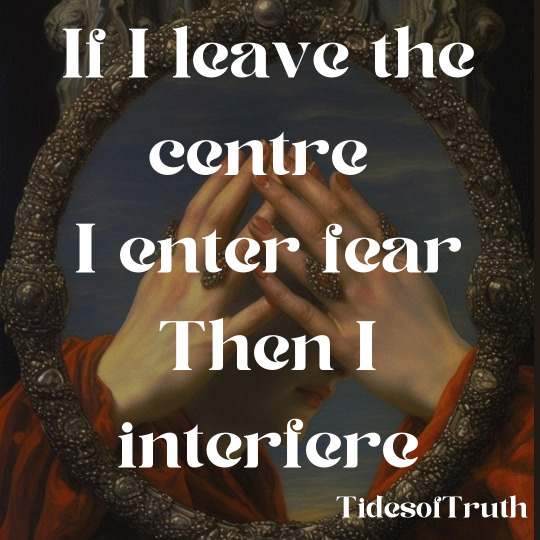


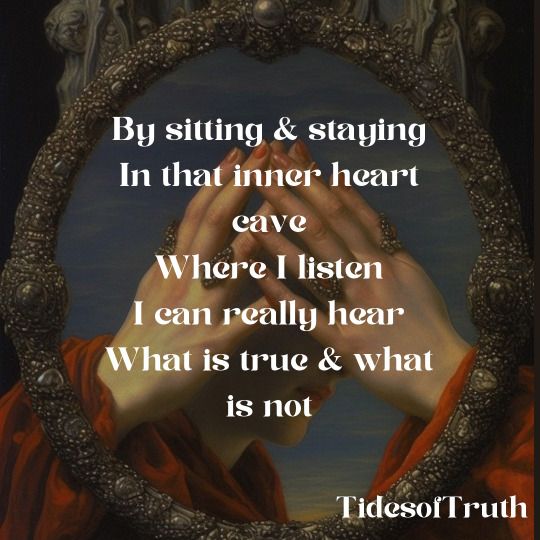
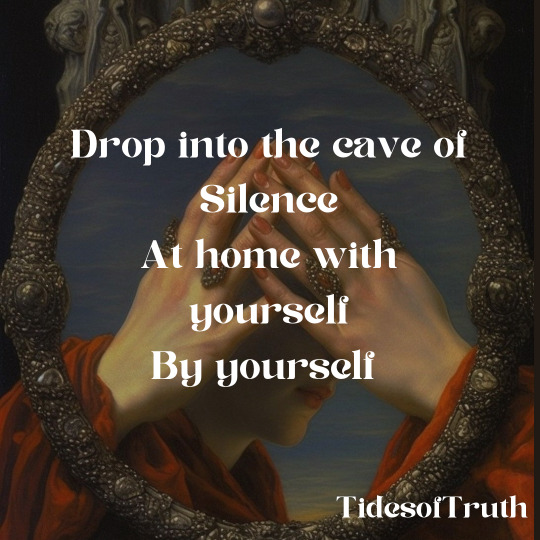

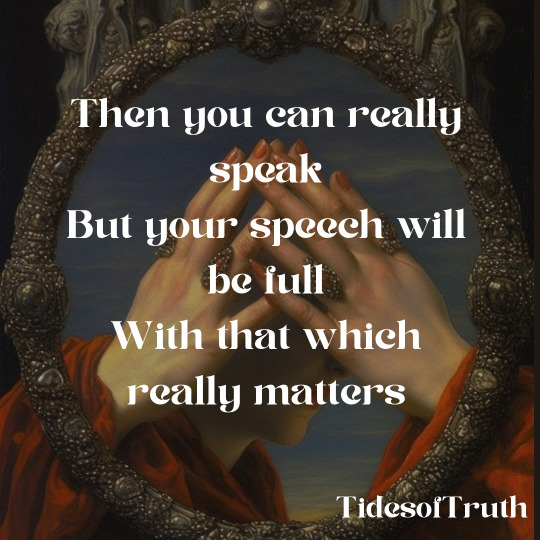
If I leave the centre , I enter fear
Then I interfere—
I forget that peace & freedom
Is first of all a resonance
That I place in the world
From inside out of
My very own core
NOT THE OTHER WAY AROUND
By sitting & staying
In that inner heart cave
Where I listen
I can really hear
What is true & what is not
Drop into the cave oi
Silence
At home with yourseli
By yourself
There your serve
In real ways-
More than you
As person can know
Then you can really speak
But your speech will be full
With that which really matters
#heartcave #hridayam #consciousspeech #silence #silencespeaks #service #fear
#consciousness#spiritual#presence#silence#hridayam#heart#heartcave#speech#conscious speech#spirituality#awareness#nonduality#divinemother#selfrealization#advaita#service
1 note
·
View note
Text
Introduction to Ayurveda: Understanding the Basics of this Ancient Healing System
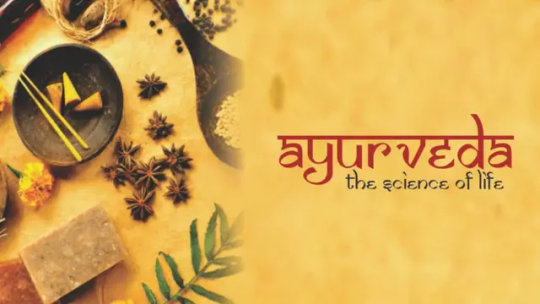
Ayurveda: The Ancient Science of Life
Ayurveda is an ancient system of natural medicine that has its roots in the Indian subcontinent. The word Ayurveda is derived from the Sanskrit language, where "Ayur" means life, and "Veda" means knowledge. Thus, Ayurveda is often referred to as the "science of life." Origin of Ayurveda Ayurveda has a long and fascinating history that dates back over 5,000 years. It is believed to have been passed down orally from one generation to another until it was eventually recorded in the form of written texts. It is based on the belief that health and wellness depend on a delicate balance between the mind, body, and spirit. Ayurveda is often called the “Science of Life” as it provides guidelines for a healthy lifestyle that can help prevent disease and promote longevity. Ayurvedic principles are based on the understanding that each person is unique, and what works for one person may not work for another. Therefore, Ayurveda offers personalized treatments that take into account a person’s individual needs, constitution, and environment. Ayurveda recognizes three doshas, or energies, that govern our body and mind: Vata, Pitta, and Kapha. Each person has a unique combination of these doshas, and imbalances can lead to physical and emotional health issues. Vata dosha is associated with movement, Pitta dosha with metabolism and digestion, and Kapha dosha with structure and stability. By understanding your dosha and its characteristics, you can make lifestyle and dietary changes to balance your dosha and promote optimal health. Ayurveda offers a range of treatments and therapies, including herbal remedies, dietary recommendations, massage, and yoga. Ayurvedic practitioners aim to restore balance to the body, mind, and spirit by identifying and treating the root cause of an ailment rather than simply masking its symptoms. Types of Ayurveda There are two main types of Ayurveda: Classical Ayurveda and Ayurvedic medicine. Classical Ayurveda is the original system of medicine that was developed in ancient India. It is based on the principles of nature and emphasizes the importance of maintaining a balance between the body, mind, and spirit. Ayurvedic medicine, on the other hand, is a more modern interpretation of Ayurveda. It is based on the same principles as classical Ayurveda but has been adapted to suit modern lifestyles and medical practices. Ayurvedic medicine includes a wide range of treatments, including herbal remedies, massages, and dietary changes. Ancient Masters and Traditions Ayurveda has been passed down through the generations by a long line of revered physicians and healers. Some of the most famous ancient masters of Ayurveda include Charaka, Sushruta, and Vagbhata. Charaka was a physician and author who is often referred to as the "father of Ayurveda." He is best known for his work on the Charaka Samhita, which is one of the most important Ayurvedic texts. Sushruta was a physician and surgeon who lived around 600 BC. He is best known for his work on the Sushruta Samhita, which is considered to be the most comprehensive text on surgery in ancient India. Vagbhata was a physician who lived in the 7th century AD. He is best known for his work on the Ashtanga Hridayam, which is a comprehensive guide to Ayurvedic medicine. Process of Ayurveda The process of Ayurveda begins with an examination of the patient's physical, mental, and emotional state. This examination is used to determine the patient's dosha, or constitution, which is based on the balance of the three main energies in the body: vata, pitta, and kapha. Once the patient's dosha has been determined, an Ayurvedic practitioner will develop a treatment plan that is tailored to the patient's specific needs. This treatment plan may include a combination of herbal remedies, massages, dietary changes, and other therapies. Benefits of Ayurveda Ayurveda has been used for thousands of years to promote health and prevent disease. It is a holistic system of medicine that emphasizes the importance of maintaining a balance between the body, mind, and spirit. Some of the benefits of Ayurveda include: - Improved digestion - Reduced stress and anxiety - Increased energy and vitality - Improved sleep quality - Reduced inflammation and pain - Enhanced immune function Incorporating Ayurveda into Daily Life Ayurveda is a way of life that can be incorporated into daily routines. Some simple ways to incorporate Ayurveda into daily life include: - Eating a healthy and balanced diet based on your dosha - Practicing yoga or other forms of exercise Cautions While Ayurveda is generally considered safe, it is important to consult a qualified practitioner before beginning any new treatments or therapies. Pregnant women, children, and people with certain health conditions may need to avoid or modify certain Ayurvedic practices. Conclusion Ayurveda is an ancient healing system that offers personalized treatments and therapies to promote balance and wellness in the mind, body, and spirit. By understanding your dosha and making lifestyle and dietary changes, you can enhance your overall health and wellbeing. However, it is important to seek guidance from a qualified practitioner before starting any new Ayurvedic treatments or therapies. Remember to always prioritize your health and wellness by staying informed and seeking professional advice when needed. Read the full article
#alternativemedicine#ancientayurveda#ancientmasters#Ayurveda#Ayurvedaforweightloss#Ayurvedaherbsforimmunity#ayurvedic#Ayurvedicdietforimmunesystem#ayurvedichealingsystems#Ayurvedicherbs#AyurvedicHerbs&itsBenefits#Ayurvedicimmunityboostingdrinks#Ayurvediclifestyle#Ayurvediclifestyletipsforbetterimmunity#Ayurvedicmedicine#Ayurvedicremediesforboostingimmunity#Ayurvedicremediesforcoldandcough#Ayurvedicremediesforcoldandflu#Ayurvedicremediesfordigestivehealth#Ayurvedicremediesfordigestiveissues#Ayurvedicremediesforhairlossanddandruff#Ayurvedicremediesforrespiratoryhealth#Ayurvedicremediesforrespiratoryissueslikeasthma#AyurvedicremediesforskinproblemslikeacneandeczemaAyurvedicsolutionsformenstrualissuesandPCOS#Ayurvedicremediesforstressandanxiety#AyurvedicRemedyForHealthyHair#ayurvedicscience#Ayurvedicsolutionsforstressandanxiety#Ayurvedicsupplementsforimmunity#Ayurvedictreatmentfordiabetesandhighbloodpressure
0 notes
Text
Crucial Facts About The Famous Ayurvedic Panchakarma Treatment

The name Panchakarma literally translates to "Five Actions," which is appropriate given that this approach focuses on five unique basic bodily functions—vomiting, purging, Niruham, Anuvaasan, and Nasyam—to regulate the body. In other words, Panchakarma is a foundation upon which the majority of Ayurveda procedures are built.
The Ayurveda principles are truly demonstrated by Panchakarma treatment , which lives up to its name as medicinal oils are used in this therapy . Here’s what you need to know about Panchakarma, including its benefits, important aspects, and more!
Signs That Panchakarma is Needed
Signs that you need Panchakarma therapy:
Uncertain mind
The tongue is covered with a thick covering.
Frequent vomiting or diarrhoea
Daylong fatigue and sluggishness
Uncontrollable appetite
Unexplained body aches
Bad breath
Improper cycles of eating and sleeping
According to the ayurvedic treatise, Panchakarma should be performed once a year so that the soul and body may support and nourish themselves.
Note: Overall, Panchakarma is beneficial for all people as the main goal of this therapy is to get rid of accumulated toxins and make us all feel better in our daily lives.
Aspects of Panchakarma Therapy
Emesis (VAMANA)
The optimal time to practise is one day after Snehana & Svedhana, after a good night's sleep, after eating, or after sunrise—from 6:00 to 9:00 or 10:00 a.m. and near to the full moon when the water aspect is high.
2. Purgation (VIRECHANA)
Purgatives remove too much Pitta from the gallbladder, liver, and small intestine where it is located.
The time of purification, as per Ashtanga Hridayam, is after Vamana (emesis) and after 9:00 a.m. After including similar Snehana and Svedana preliminary procedures, the therapy is carried out.
3. Medicated enemas (BASTI)
Basti therapy is typically applied to excess Váyu, either on its own or when the prevailing dosha is out of balance. The Sanskrit word for the urinary bladder is Basti.
Since the colon is connected to all other organs and tissues, toning and cleansing the colon can cure and rejuvenate the entire body. The colon is the primary organ for nutrient absorption. The effective absorption of nutrients depends on a colon that is active and healthy.
4. Medicated nasal oils (NASYA)
Nasya has been shown to enhance hearing, smell, eyesight, and avoid hair loss, grey hair, tense necks, migraines, and lockjaws. You take Nasyas before meals.
It is advised against consuming these Nasyas in cloudy weather and to take them first thing in the early morning on an empty stomach.
5. Toxic bloodletting (RAKTAMOKSHAN)
Release of poisonous blood from different body places is known as restorative toxic bloodletting (Raktamokshana). The typical amount of blood discharged is 2 to 8 ounces.
Benefits of Panchakarma Treatment
The following are the top four advantages of panchakarma:
Improves eating & sleeping patterns: The treatment plan outlines a balanced and healthy lifestyle. It requires eliminating harmful eating habits, practising meditation and yoga, getting sufficient sleep, and maintaining a nutritious diet. The same can be included into our daily routines as a beautiful approach to thank the body.
2. Detoxing the body & rejuvenating the mind: Rejuvenating the mind and body through detoxification The procedure promotes digestive fire and flushes toxins (ama) because it concentrates on the cleaning of the system at different levels in Agni. It reinstates the body's inherent capacity for healing.
3. Reduces Body Weight: A tried-and-true method of losing weight is to get panchakarma therapy. The body is unable to exfoliate the dead cells due to the accumulated toxins, which contributes to weight gain. The elimination of toxic weight and restoration of the body's innate capacity to maintain appropriate weight are implied by the eradication of ama.
4. Reduces Stress: Stress is a destroyer of health. The panchakarma chikitsa guarantees that blocked channels are cleared to allow the body's natural energy to flow, reducing stress and advancing wellness.
Bottom Line
It is crucial to establish a robust digestive fire and remove the body's toxins in order to achieve a healthier lifestyle. This holistic remedy called Panchakarma detoxifies the system and restores its inner equilibrium and vigour.
It is important to know that therapies with Panchakarma treatment should be avoided during fever, injury, and pregnancy. Before undergoing Panchakarma therapy, you should speak with a certified and experienced Ayurveda doctor so that the doctor may create a plan of treatment that takes into account your current health.
0 notes
Text
The Importance of Data Security and Compliance in Document Workflow Automation

In today's fast-paced digital world, the use of Workflow Management Software has become an essential component of business operations. Document Workflow Automation is a critical element of Workflow Automation Software that streamlines document workflows, thereby enhancing efficiency, reducing costs, and increasing productivity. However, with the increasing use of these tools, data security and compliance have become significant concerns.
The Importance of Data Security
Data security is of utmost importance in today's data-driven world. Workflow Automation Software is designed to automate repetitive and time-consuming tasks, reducing the risk of human error. However, as the use of these tools grows, the potential risk of data breaches also increases.
Data breaches can result in a range of negative consequences, including financial loss, damage to a company's reputation, and legal liability. The risk of data breaches is particularly high when dealing with sensitive or confidential information. Therefore, it is crucial to ensure that data security measures are in place to protect confidential information.
The Importance of Compliance
Compliance refers to the adherence to legal, regulatory, and industry-specific standards. In the case of Document Workflow Automation, compliance is particularly important because of the sensitive nature of the information being processed. Failure to comply with relevant regulations can lead to severe consequences, including fines, legal action, and reputational damage.
Compliance requirements vary depending on the industry, the type of information being processed, and the location of the business. However, there are several general principles that apply to most businesses, such as data protection, confidentiality, and record-keeping.
The Benefits of Data Security and Compliance
By implementing data security and compliance measures, businesses can protect themselves from potential data breaches and legal liability. Additionally, adhering to relevant regulations can help build customer trust and enhance the company's reputation.
Moreover, using Workflow Automation Software that incorporates data security and compliance features can help reduce the time and effort required to ensure compliance. This not only reduces the risk of non-compliance but also saves valuable time and resources that can be directed towards other business operations.
The Role of Workflow Automation Tool in Data Security and Compliance
Workflow Automation Software can help ensure data security and compliance in several ways. For example, by automating the document review and approval process, it ensures that only authorized personnel have access to sensitive information. Additionally, it can track and record all document-related activities, providing a clear audit trail for compliance purposes.
Furthermore, Workflow Automation Tool can enforce compliance by limiting access to certain documents or folders based on user roles and permissions. This ensures that only authorized personnel can access sensitive information, reducing the risk of data breaches.
Conclusion
Data security and compliance are critical elements of Workflow Automation Software. By implementing data security and compliance measures, businesses can protect themselves from potential data breaches and legal liability while enhancing customer trust and the company's reputation. Workflow Automation Tools can play a crucial role in ensuring data security and compliance by automating document workflows, enforcing access controls, and providing an audit trail. Therefore, it is essential to choose a reliable and trustworthy Workflow Automation Tool to ensure the security and compliance of your document workflows. In this regard, Hridayam Soft Solutions Pvt. Ltd. offers an excellent Workflow Automation Tool that provides data security and compliance features to streamline your document workflows.
0 notes
Text
Benefits of Chyawanprash-Perfectveda
The ancient Ayurvedic texts Ashtanga Hridayam, Charaka Samhita, and Sangandhara Samhita all describe the Chyawanprash formula. Ayurveda is a science that focuses on both curative and preventive medical care, and as a result, it has recommended herbs and other techniques to boost immunity and prevent disease. Rasayana is an Ayurvedic branch that aims to extend life, prevent disease and ageing, eliminate degenerative processes, and promote health. Rasayana herbs boost the body's resistance and protect it from disease.
The Rasayana drugs are mainly classified as:

Kamya Rasayana: For promotion of health
Naimittika Rasayana: For the cure of diseases
Medhya Rasāyana: All the Rasāyana drugs also improve the mental health
Ācāra Rasāyana: The established rules of conduct, are also considered as means of Rasāyana, which are known as ĀcāraRasāyana
Chyawanprash is a Kamya Rasayana that improves a person's health and vigour. Because of its antioxidant properties, chyawanprash improves vigour and vitality and slows the ageing process. Chyawanprash is made by first making a herbal decoction, then drying the extract, mixing it with honey, and adding aromatic herbal powders. Chyawanprash's main ingredient is Amla, which is high in vitamin C and acts as an immunomodulator with anti-aging properties. Chyawanprash contains over 45 nutrient-rich herbs, including

Ashwagandha which is an Antioxidant, aphrodisiac, and adaptogen Bala which nourishes all the Dhatus Pippali activates Agni or digestive fire and improves metabolism. It also pacifies Vata and Kapha Doshas Draksha helps improve immunity Gokshura helps with digestion, is useful in the management of Urinary Disorders, and is beneficial for eye health Shatavari boosts immunity Brahmi is an antioxidant which boosts brain functions Guduchi removes ama in the body and improves immunity Pushkara help treat respiratory concerns and cough. Its antiviral and antibacterial properties help the immune system fight pathogens
Chaturjata: Made of four ingredients that balance Kapha dosha in the body. Since it is loaded with nutrient-rich herbs, it shows benefits in all the organ systems:
It is called tridosha shamaka. Boosts gut fire or agniRochana (stimulates appetite), Enhances digestion and metabolism. Detoxifies the body and purifies the blood Treats nausea, vomiting, and bloating while also promoting liver function. It defends and strengthens the respiratory system. Improves fertility, Cardiac tonic, improves sense organ function Skin tone is improved. Beneficial to hair Chakushya (treats eye problems) (treats eye problems), It slows down the ageing process. Diabetes is managed. Improves intelligence and brain cell nourishment, Increases strength, Prevents infections The endocrine system is balanced. Enhances ojas Calms the nerves and alleviates anxiety.
Adults should take 2 teaspoons of Chywanprash for Daily Health with milk twice daily before meals. Pitta prakriti individuals with acidity issues should consume it with milk. It should be taken before meals if possible, and in smaller amounts if the digestive system is weak. It is also beneficial to children because it boosts immunity and promotes growth. Children can take 1 teaspoon of Chyawanprash twice daily. They will also enjoy Chyawan Gummies, which are gummy versions of Chyawanprash. Ayurveda believes in maintaining health by maintaining a good mind-body balance and building a strong immune system. As a result, Rasayanas like Chywanprash, along with a healthy diet and regular exercise, are beneficial to one's health and wellbeing.
For Mor visit us at www.perfectveda.com
1 note
·
View note
Text
Thanks for the tag!
Rait Zara Si by Arijit Singh and Shashaa Tirupati
Melting by Kali Uchis
Sanctuary by Joji
It Has Begun by Starset
Petals on the Moon by Wasia Project
Brand New City by Mitski
Pasoori by Ali Sethi and Shae Gill
Darshana from Hridayam
pink diamond by Charli XCX
Judas by Lady Gaga
@wanderingbreadknight @novaae @voidsteffy @ashlakh @shyreol @dreaming-of-our-firstborn @tumkaafiho
10 Songs, 10 People
Thankyou so much @buginateacup for tagging me in this ^^
I’ll tag:
@proupagandist
@sheriiam
@hergan416
@methpring
@shreddedleopard
@shadowstarkanada
@aihakei
@shinyphoenix
@cyborg-squirrel
@a-really-hot-caterpillar
Rules: Put your music on shuffle and list the first 10 songs that come up.
I'm gonna go with my iPod's masterlist for this - it's about 2000 songs long... and there is no theme. At all. (If I did my current one, it'd all be Cocoa Otoko, and while I love representing, that's no fun.)
Let's go~
Let's Have a Home Party (orig. ホームパーティをやろう) - MUSICAL HETALIA THE BEST 「always love」
Mooning - GREASE
The Closer - VIXX
Growing Pains (너는 나만큼) - Super Junior D&E
Reunited - Undertale the Musical (Toby Fox ft. Alex Beckham)
Out of Love - FTISLAND
Bad Boy - Cascada
Desire - ATEEZ
Faded - Alan Walker
The One That Got Away - Katy Perry
...welp that's certainly a mix there.
143 notes
·
View notes